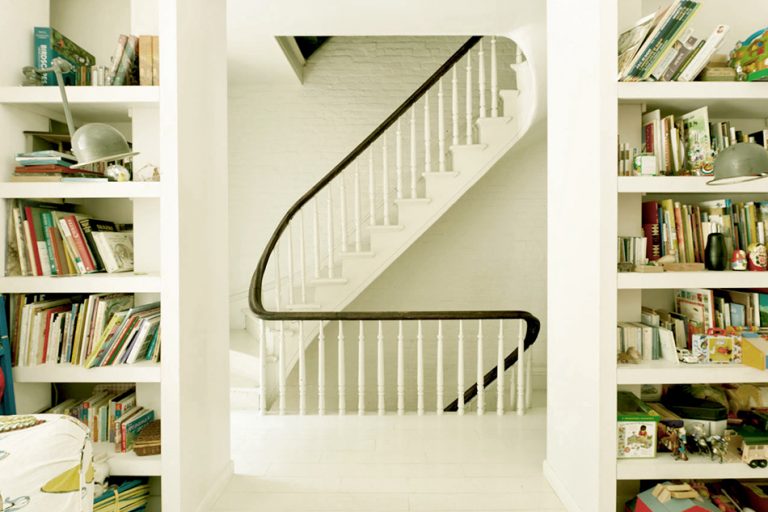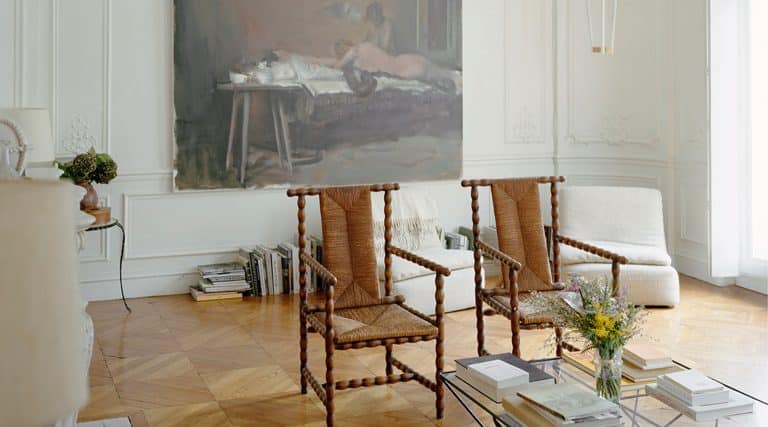
January 2014The photographer with his work. Top: A still-life at Chatsworth by Halard including Lucian Freud‘s Eggs, 2002. All photos © Francois Halard/Rizzoli
When François Halard was a boy, growing up in an 18th-century house in Paris, the photographer Helmut Newton came to shoot a fashion story there. “A lot of photographers were using it as a location then,” explains Halard, whose parents are the celebrated French decorators Michelle and Yves Halard. Watching Newton work was a revelation to the introverted 12-year-old. “I realized I could interact with the world using the camera as a kind of protection.”
He spent subsequent summer holidays working as a photographer’s assistant, and then, while a student at the École Nationale Supérieure des Arts Décoratifs, he met the legendary Parisian editor in chief Marie-Paule Pelle, who would become his mentor and friend, and with whom he began to work at the then-avant-garde interiors magazine Décoration Internationale.
By the age of 25, Halard had been noticed by no less an aesthete than Alexander Liberman, the longstanding editorial director of Condé Nast in the United States, who hired him to shoot fashion and lifestyle stories for House & Garden, GQ, Vanity Fair and Vogue. For the past 20 years, he has collaborated closely with Vogue’s Anna Wintour.

Among the outstanding interiors shot by Halard is Villa Kérylos, in Beaulieu-sur-Mer, France, built in the early 1900s and now a museum.
Halard is undoubtedly among the most sought-after interiors and architectural photographers of our time, widely known for capturing the world’s most beautiful homes and the people who inhabit them. Much of his work was collected in the best-selling 2007 coffee-table volume Vogue Living: Houses Gardens People, and, in November, Rizzoli published François Halard, a collection of the photographer’s own personal images of the artists, designers, architects, tastemakers and great 20th-century interiors for which he has a special affinity. (An exhibition of his architectural images can be seen at New York’s Demisch Danant gallery from February 1 through March 1.)
“It’s really a collection of memories, a tribute to the people and the places that have inspired me over the years,” says Halard, who wrote short, stream-of-consciousness texts to accompany the images, revealing his thoughts and feelings as well as memorable anecdotes from each photo session. “The goal was to translate the emotional impact of the different subjects in a fluid, almost dreamlike way,” he says.
One of Halard’s hallmarks as a photographer is his gift for creating an air of effortless elegance in his portraits of both people and houses. His signature vignettes — papers piled high on a writing desk, collections of seemingly mundane objects, a single flower wilting in a vase — capture the most telling details of a life well lived. Through his images, he brings intimacy to the grandest of subjects and reveals the intrinsic beauty of the simplest of gestures.

Gogo Schiaparelli’s Egyptian-and-Chinese-accented apartment, in Paris, which Halard shot in 1992, echoes the memory of her mother, fashion icon Elsa, and her grandfather, an Egyptologist, among other influences.
Take, for example, the pictures he made of the Dowager Duchess of Devonshire at Chatsworth, her late husband’s ancestral home. Here, Halard gives as much attention to a collage of ribbons awarded to the Dowager Duchess’s brown and buff crossbreed chickens as to the magnificent 1902 portrait of family members by John Singer Sargent hanging in a grand drawing room. Or consider his work capturing the Italian studio of American artist Cy Twombly. A double-page spread depicting a single squiggled detail of the maestro’s painterly writing follows a portrait of the man himself and a series of still-life vignettes showing his tools and the other objects with which he surrounded himself. We see the impressive height and structure of the living room of La Maison de Verre, the famed modernist house in Paris designed by Pierre Chareau, which was the subject of Halard’s first book. (He lived in an apartment across the courtyard for a dozen years.) But it’s the details of a metal screen, a lamp on a bedside table and reflective aluminum panels in a bathroom that allow us to experience what it might feel like to experience the space in person.
The book is made up of 41 such projects, and the table of contents reads like a roll call of the 20th century’s most iconic style-setters: Coco Chanel, Yves Saint Laurent, Axel Vervoordt, Richard Avedon, Julian Schnabel. Each subject has its own highly individual poetic magic, from the intimacy of the monastic lifestyle of architect Albert Frey, revealed in the images of his modernist home in the California desert, to the haunting magnificence of the abandoned Casa Malaparte, perched on a rocky promontory on the island of Capri.

It took 10 years for Halard to gain access to Casa Malaparte, the striking house — featured in Jean-Luc Godard’s 1963 film Contempt — perched on an isolated promontory in Capri.
“His work has a painterly effect,” says interior designer Michael Misczynski, of Los Angeles decorating duo Atelier AM, who worked closely with Halard to photograph the team’s projects for a 2012 Rizzoli book of its own. “It’s as if he captures the emotion, the vibrations, inherent in the space, but also, and one might argue equally, his own appreciation of it, his own feelings.”
Today, when he’s not traveling, Halard lives between an apartment in New York and one in Paris, plus his primary residence in Arles, in the South of France: a 20-room, 18th-century hôtel particulier that he first came across in 1990. At the time, the rambling pile was in a state of great disrepair, with neither electricity nor plumbing.

“Halard’s photographs reveal to us the hidden underside of a world that is our own and which we do not always know how to see,” writes Pierre Bergé in the book’s preface.
The lack of modern amenities notwithstanding, the house seduced him immediately, in no small part due to the original Louis XVI wallpaper in the bedrooms and the trompe l’oeil panels depicting “The Birth of Rome” in the drawing room. The renovation and decoration of the property have played an important role in his creative life ever since. Functioning both as a home and a studio, it’s a place where the various themes running through his work — beauty, perception, the revelatory qualities of the things that surround us — find a connection.
Halard writes of his home in the book, explaining its ongoing magic. “For me, it’s the snow on the palm trees in winter, the red color of a bouquet of peonies, the yellow of a Provençal bedspread, the pink of the grand staircase, the gray of Marie-Antoinette on the walls of my room, an accumulation of books and objects. It’s a house that is transformed into a studio, the idea of a reinvented family home.”
 The book takes us on a journey to dozens of magical homes, but in the end, the one that most inspires Halard is his own.
The book takes us on a journey to dozens of magical homes, but in the end, the one that most inspires Halard is his own.



